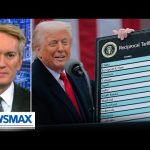President Donald Trump’s decision to impose a 25% tariff on imported automobiles has ignited fierce debate across the political and economic spectrum. While progressive critics have labeled the move a reckless tax hike that will burden American consumers, Trump and his supporters argue that these tariffs are a necessary step to revive domestic manufacturing and secure America’s economic future. The tariffs, which cover nearly $600 billion worth of vehicles, auto parts, and even computers, represent one of the most sweeping trade measures in decades.
The immediate impact of these tariffs is expected to be felt by consumers, with prices for imported cars potentially rising by $10,000 to $15,000 per vehicle. Economists warn that this could lead to decreased demand for new cars, job losses in related industries, and disruptions to global supply chains. Critics also point out that many vehicles assembled in the U.S. rely heavily on imported components, meaning domestic manufacturers will face higher production costs as well. This ripple effect could undermine Trump’s goal of reshoring auto production, as companies weigh the costs of relocating factories against the uncertainties of U.S. trade policy.
Despite these challenges, Trump remains confident that the tariffs will ultimately benefit American workers and businesses. He has framed the policy as part of a broader effort to reduce dependence on foreign manufacturing and protect critical industries from unfair competition. Supporters argue that short-term economic pain is a small price to pay for long-term gains in job creation and industrial growth. They point to past successes during Trump’s first term when similar tariff threats prompted investments in U.S. factories by companies like Hyundai and Volkswagen.
However, skeptics question whether the administration’s approach will deliver the promised results. Many automakers have expressed hesitation about relocating production due to high labor costs, aging infrastructure, and uncertainty surrounding future trade policies. Additionally, retaliatory tariffs from trading partners like Canada and Mexico could further complicate efforts to stabilize supply chains and boost exports. Goldman Sachs has already lowered its U.S. GDP growth forecast for 2025, citing risks associated with these tariffs.
The broader implications of Trump’s tariff strategy extend beyond the automotive sector. By targeting such a wide range of imports, including computers and intermediate goods, these measures risk fueling inflation and slowing economic growth at a time when consumers are already grappling with high prices and interest rates. Critics argue that this approach could backfire politically if Americans begin feeling the pinch at checkout counters or dealerships.
Ultimately, Trump’s tariffs represent a bold gamble to reshape U.S. trade policy and restore America’s manufacturing dominance. Whether this gamble pays off or leads to economic turbulence remains to be seen. For now, both supporters and detractors agree on one thing: these tariffs mark a pivotal moment in America’s ongoing struggle to balance economic nationalism with global interdependence.




